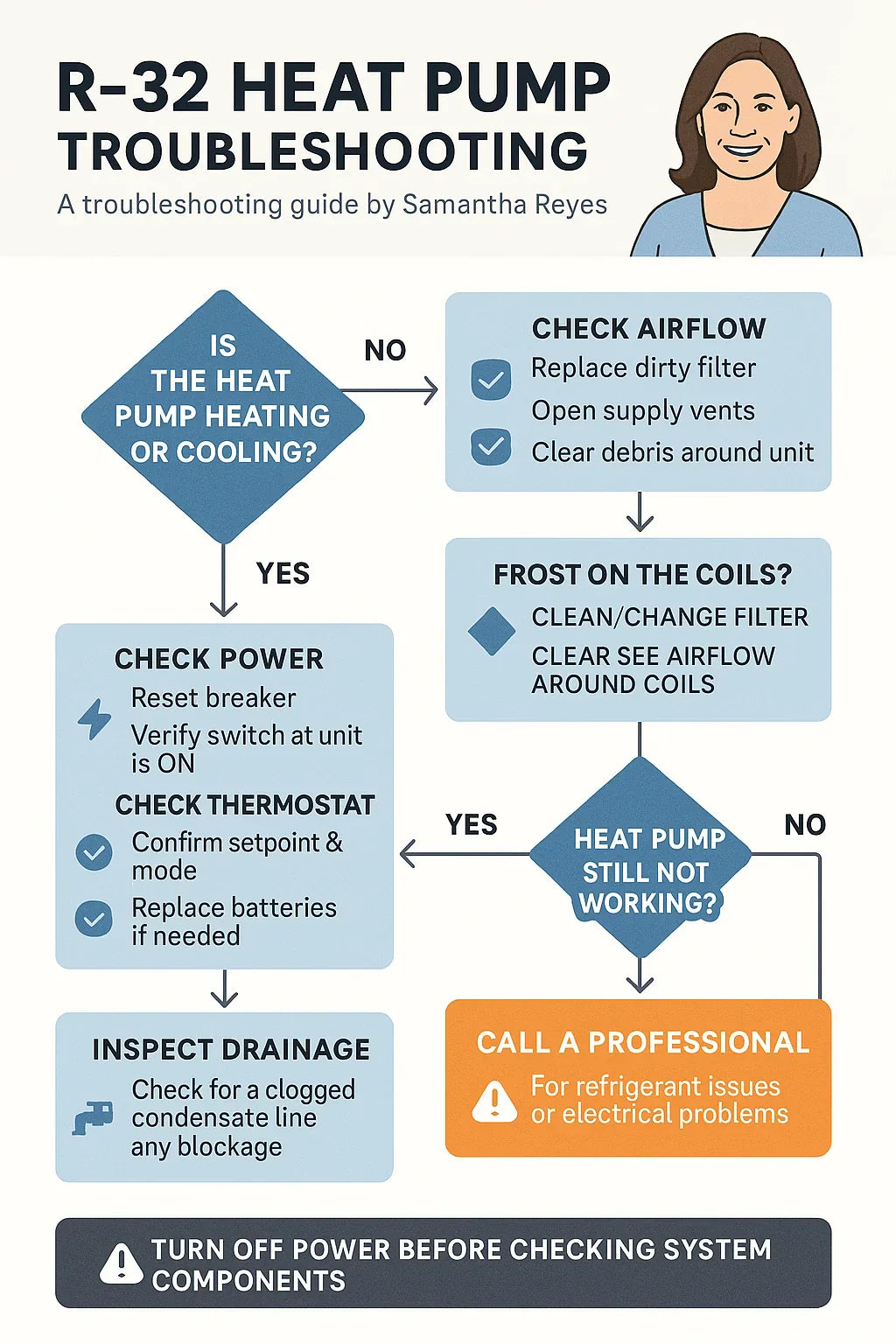💬 Introduction: Samantha’s “Cold in July” Moment
Last summer, I woke up sweating at 3 a.m. My thermostat said 72°F, but my R-32 heat pump was blowing warm air in cooling mode. My first thought? Great… now I’m going to have to pay for an emergency service call.
But before reaching for my phone, I went through a checklist I’d learned from my installer. Ten minutes later, I had cool air flowing again—no technician required.
If your R-32 heat pump stops heating or cooling, this guide will help you figure out whether it’s a simple fix or a job for a certified HVAC pro.
📋 Safety First: Don’t Skip This
Before touching anything:
-
Turn Off the Power – Switch off the heat pump at the thermostat and the breaker panel.
-
Know Your Limits – R-32 refrigerant is an A2L mildly flammable refrigerant (EPA R-32 Safety Overview).
-
Refrigerant Handling – U.S. law requires an EPA Section 608 certification to handle refrigerants (EPA Section 608 Rules).
-
Electrical Risk – Outdoor units run on 240V—always use insulated tools and avoid contact with wiring unless you’re qualified.
⚡ Step 1: Check Power & Thermostat Settings
Sometimes the simplest fix is the right one.
-
Check the Circuit Breaker – A tripped breaker may be the only thing stopping your system. Reset it and see if the unit restarts.
-
Inspect the Disconnect Switch – Located near your outdoor unit; it should be in the “ON” position.
-
Verify Thermostat Mode – Ensure it’s set to Heat or Cool and not Fan Only.
-
Battery Check – If your thermostat is battery-powered, weak batteries can cause erratic operation.
🌬 Step 2: Airflow Inspection
Restricted airflow can make your heat pump look broken even if it’s fine.
-
Replace Dirty Filters – A clogged filter can cause overheating in cooling mode or ice buildup in heating mode.
-
Open All Vents – Closed vents increase system pressure and reduce efficiency.
-
Check Return Air Path – Make sure furniture or rugs aren’t blocking airflow.
The Energy.gov Maintenance Guide recommends replacing filters every 1–3 months, especially during heavy use.
❄️ Step 3: Outdoor Unit Check
-
Clear Debris – Remove leaves, dirt, and grass clippings from around the condenser. Maintain at least 24 inches of clearance for airflow (Daikin Install Manual).
-
Check for Ice – In cooling mode, ice on the outdoor coil often means low airflow or low refrigerant.
-
Inspect Coil Fins – Bent fins can restrict heat exchange; use a fin comb to gently straighten them.
🧊 Step 4: Defrost & Mode Settings
If your heat pump is in heating mode and you see frost on the outdoor coil:
-
Normal – Heat pumps periodically go into defrost mode to melt ice. You’ll hear a swish in airflow and possibly see steam.
-
Not Normal – If frost doesn’t clear after 15–20 minutes, you may have a sensor or refrigerant issue.
💧 Step 5: Drainage & Condensate Lines
Blocked condensate drains can trip safety switches that shut the system down.
-
Check Drain Pan – If it’s full of water, your drain line may be clogged.
-
Clear the Drain – Use a wet/dry vacuum at the outdoor end of the condensate line.
-
Add Vinegar Flush – Pour 1 cup of distilled vinegar into the drain line every few months to prevent algae buildup (AC Drain Line Cleaning Tips).
🛠 Step 6: When It Might Be Refrigerant
Low refrigerant charge is a common cause of poor heating or cooling, but with R-32, only certified pros can check or recharge the system.
Possible Signs of Low Charge:
-
Air feels only slightly cool or warm compared to set temperature.
-
Outdoor unit runs constantly without reaching setpoint.
-
Ice buildup on the indoor or outdoor coil.
R-32 requires A2L-rated tools and safety procedures (AHRI A2L Guidelines), so this is not a DIY fix.
📞 Step 7: Call a Licensed Pro
If you’ve checked the basics and your heat pump still isn’t performing, it’s time to call a technician.
When you call, have this info ready:
-
Model and serial number.
-
Symptoms (heating, cooling, noise issues).
-
Steps you’ve already taken.
-
Any error codes from your thermostat or control board.
A service visit typically involves:
-
Electrical and control board diagnostics.
-
Refrigerant pressure and temperature readings.
-
Leak detection (if refrigerant loss is suspected).
📊 Quick Troubleshooting Reference Table
| Symptom | Possible DIY Fix | When to Call a Pro |
|---|---|---|
| No heating or cooling | Check breaker, thermostat, air filter | If still unresponsive |
| Weak airflow | Replace filter, open vents | If blower motor is faulty |
| Ice on coil | Check airflow, clear debris | If refrigerant issue suspected |
| Unit cycles frequently | Clean filters, check thermostat placement | If refrigerant or control board issue |
| Water leak indoors | Clear condensate drain | If persists after cleaning |
💬 Closing Thoughts
Heat pumps are reliable, but even the best R-32 systems can have hiccups. By knowing which issues you can safely handle and which require a professional, you can save time, money, and avoid unnecessary discomfort.
My rule of thumb: If it involves refrigerant, high voltage, or taking apart sealed components—call the pros. Everything else? You might just be able to fix it in 15 minutes.
In the next topic we will read about: Is a 3‑Ton R‑32 Heat Pump Right for Your Home? Sizing Tips & Layout Guidance







